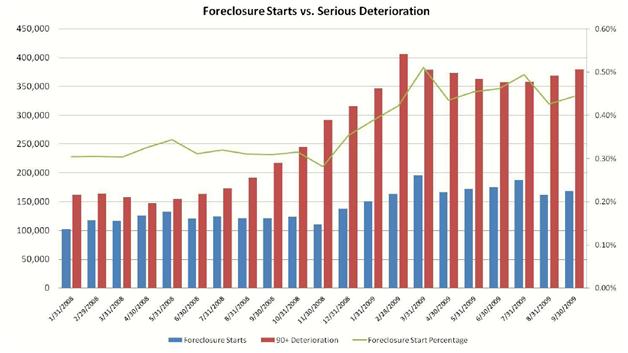Extend and pretend and the growing divide between delinquencies and foreclosures
Annaly Capital Management’s blog has a good piece up on foreclosures, inspired by yesterday’s Case-Shiller data (hat tip Scott). If you missed it, The S&P/Case-Shiller index showed a pretty steep 1.2% month-on-month increase in U.S. house prices in its latest figures (for August 2009). This is the fourth consecutive month of increases, signaling to some that residential real estate prices have bottomed (see my post on Case-Shiller here).
Not so fast. First, we need to see this trend hold through the winter months after incentives have dissipated and after the summer selling season is less of a factor driving sales. But, there’s something more ominous lurking in the data, and Annaly points this out. It’s the growing gap between delinquencies and foreclosures.
The S&P/Case-Shiller Home Price Index grew 1.2% month-over-month, and expanded for the third month in a row, according to data released this morning. It would appear that the housing recovery is upon us. To maintain this sunny outlook, we advise readers to please stop their analysis of the health of the housing market right there. For braver souls, LPS (a provider of data and services to mortgage lenders and servicers) releases its Monthly Mortgage Monitor in the middle of every month. The growing disparity between delinquencies and foreclosure starts is in focus in the chart below, from October’s release.
As the graph illustrates, delinquencies are rising, but foreclosure starts are not. As of September 2009, 90+deterioration more than doubled actual foreclosure starts. LPS has dubbed this “shadow foreclosure inventory.” Higher unemployment begets delinquencies and defaults, but foreclosures aren’t flowing through due to modification efforts and various moratoria. Depending on the success of programs like HAMP, more than a few of these loans are still destined for foreclosure.
This is the result of what is known as extend and pretend because a rolling loan gathers no moss or credit writedowns, but does gather fee income. On the one hand, a lot of home owners are finding it difficult to get loan modification terms. But, on the other hand, mortgage delinquencies have more than doubled since the recession began, so the absolute number getting modifications has risen. The question is not so much whether enough modifications are being done, but rather under which circumstances are lenders modifying loans.
The Annaly data and graph above suggest that lenders are actually modifying a decent number of mortgages that fall delinquent – so much so that foreclosure statistics understate the overall distress in the housing market. So, this is a little bit of damned if you do, damned if you don’t as far as banks are concerned. On the one hand, they are getting pilloried for not modifying loans. Yet, on the other hand, in modifying loans they can be accused of “delay and pray” tactics in order to avoid writedowns. Both accusations seem fair given the enormous increase in foreclosures. Nevertheless, you can understand the dilemma. If you want a real-life story about how extend and pretend works in practice, see my post, “Short Sales in North County: “Feeding Frenzy” as banks pretend and extend.”
These cases are where the shadow inventory everyone keeps talking about comes from: houses that have not been foreclosed but where delinquencies show an increased probability of foreclosure, especially in a weak economic environment.
For banks looking to husband capital, it makes sense to extend and pretend where one thinks there is a reasonable chance that this will result in fewer loan losses. But, at the same time, given the securitized nature of the mortgage market, it is mortgage servicers which have an increased measure of control in loan modifications. And their incentives do not appear to align with those of the mortgagees. Time will tell how all of this impacts house prices.
Source
Who Knows What Evil Lurks In The Hearts of Men? – Annaly Salvos

Comments are closed.